Easy Homemade White Sandwich Bread

Easy Homemade White Sandwich Bread
This easy white bread recipe uses simple, everyday ingredients and yields a chewy, soft loaf perfect for sandwiches or toasting.

This easy white bread recipe uses simple, everyday ingredients and yields a chewy, soft loaf perfect for sandwiches or toasting.
Over the past year, this easy white sandwich bread recipe has become my go-to. It uses simple, everyday ingredients that you probably already have in your kitchen. The result is a chewy, flavorful loaf that’s perfect for sandwiches or toast.
During the pandemic in 2020, I became more conscious of the ingredients in store-bought bread. Many brands include unnecessary additives, preservatives, and chemicals that I’d rather avoid. The desire for a healthier option led me to start baking my own bread, and this recipe has been a game-changer.
You can mix and bake this bread in just about 2 1/2 hours, giving you a soft, delicious loaf that lasts for about a week. If you want to make a larger batch, the recipe can be easily doubled using the scale button below. Plus, you can wrap and freeze extra loaves for 3 to 6 months, which is super convenient for busy days.
While this recipe does call for bread flour, I’ve successfully made it with all-purpose flour as well, with equally great results. I personally enjoy baking one loaf at a time, but having extra bread in the freezer is a nice backup for those times when I don’t feel like running to the store.
Enjoy the satisfaction of homemade bread with this simple, reliable recipe!






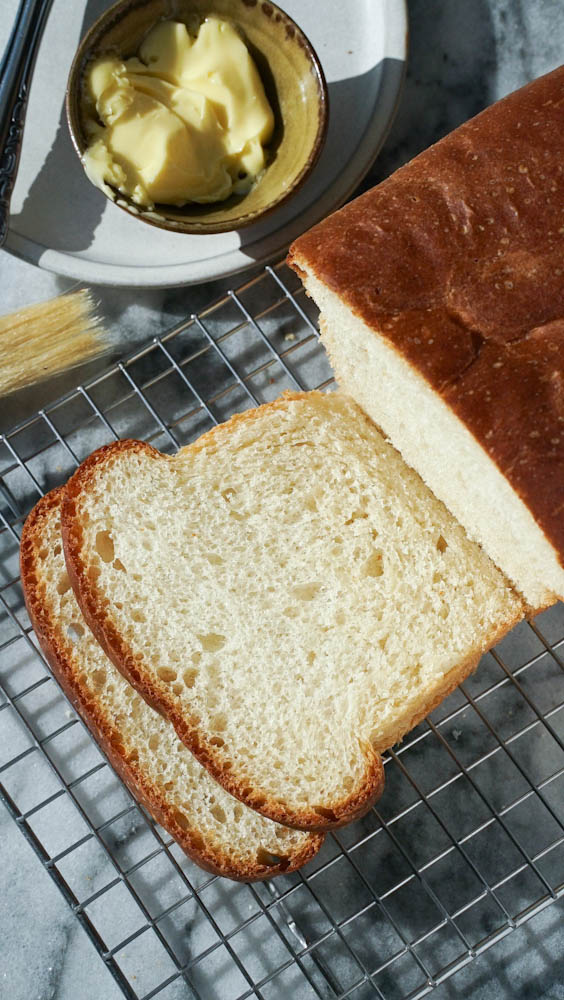







PRO TIP/ KITCHEN HACK
Utilizing a convection oven: it is prudent to make a conscious adjustment by reducing the oven temperature by 25°F, accompanied by a corresponding reduction in baking time, as convection ovens tend to hasten the baking process.
1. Blooming the yeast – In a liquid measuring cup, pour 240ml of lukewarm water (between 100F-110F). Sprinkle in 1/2 tsp of sugar and stir to dissolve – this will help the yeast to feed and bloom. Sprinkle the yeast into the water and then stir for 20 seconds so that the water is cloudy and there is no visible yeast on the water’s surface. Allow the yeast to sit undisturbed for 10 minutes. You should now have a foamy dome of bloomed yeast sitting on your water -congrats! Your yeast is now ready to be incorporated into the recipe!
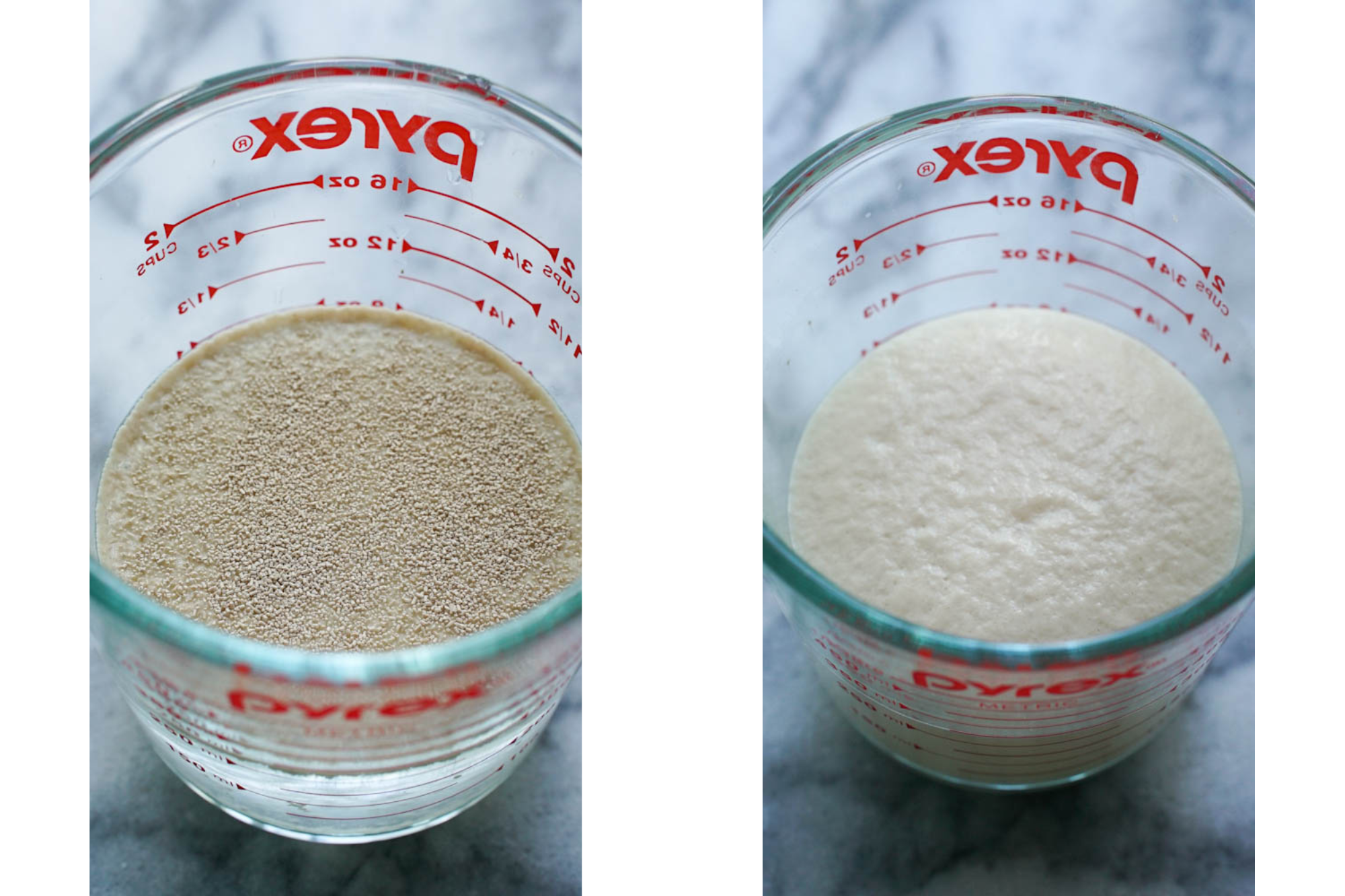
2. Mixing the dough – Using a stand mixer (or by hand with extra elbow grease), knead the dough for 8-10 minutes. The dough should become elastic and smooth and no longer leave a sticky residue when touched. Finish with the window test to ensure enough gluten has formed in your dough. Pull off a small piece of dough and roll it into a ball with your fingers. Then, gently stretch the dough by both ends and create a thin window to see the gluten strands formed in a web. Fold the dough into a ball with the seams on the underside.
3. First Proof – Oil a large bowl and place your dough inside; cover with a towel and allow the dough to rise for 1 hour (or until double in size). The dough should form small gas pockets and bounce back when gently poked. Remove the dough from the bowl onto an oiled workbench. Punch down on the dough to release the gas that has accumulated inside, and roll it out to a rectangle 8 x 16 inches. Starting on an 8-inch end, begin rolling the dough upwards to create a log, then connect both ends. Allow the dough to rest with the connected ends underneath to help secure the seams.
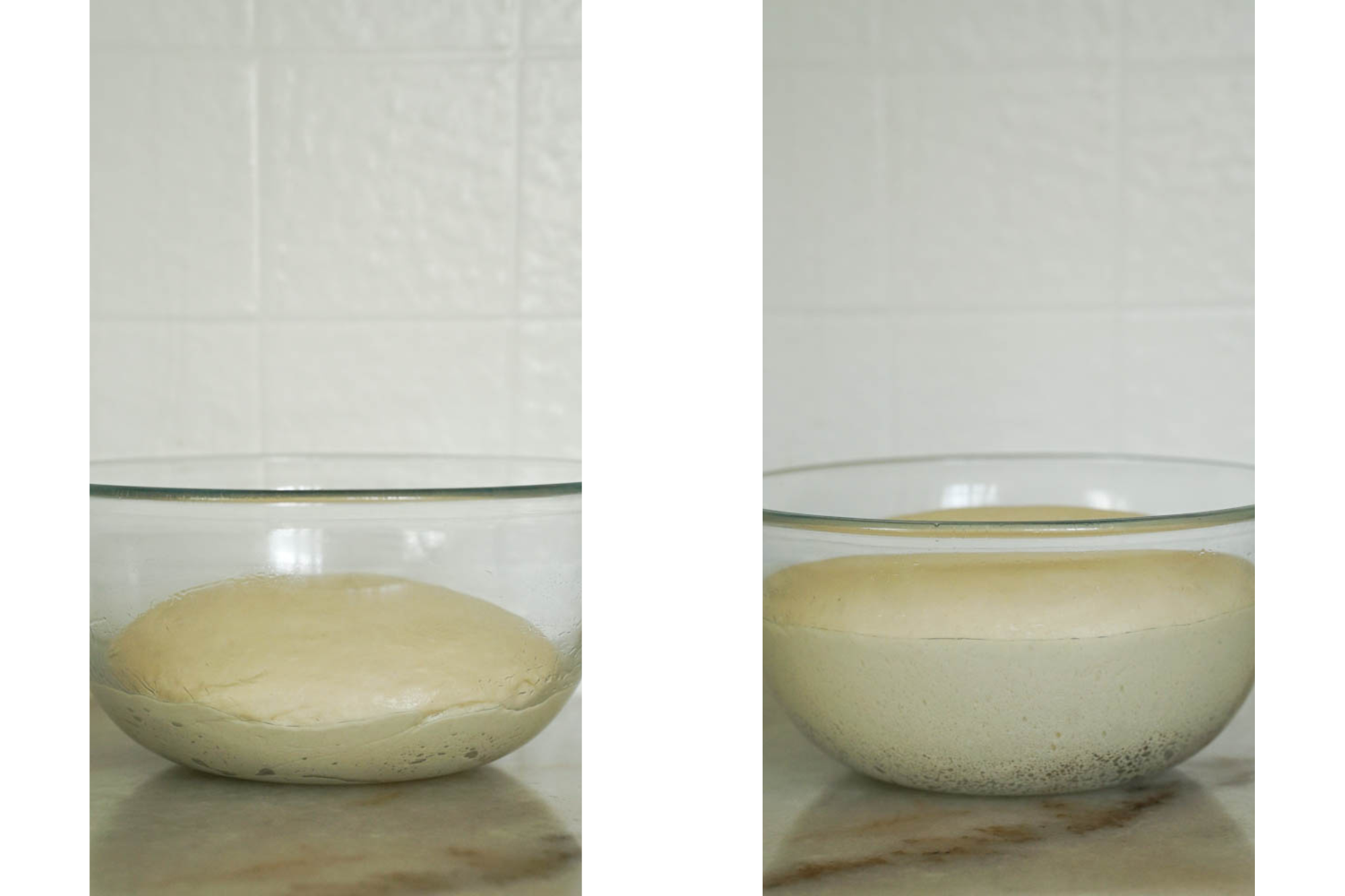
4. Second Proof – Oil the loaf pan and place the bread dough inside with the joined seams facing down towards the bottom. Cover again loosely with the towel and allow to rise again for another 45 minutes to an hour.
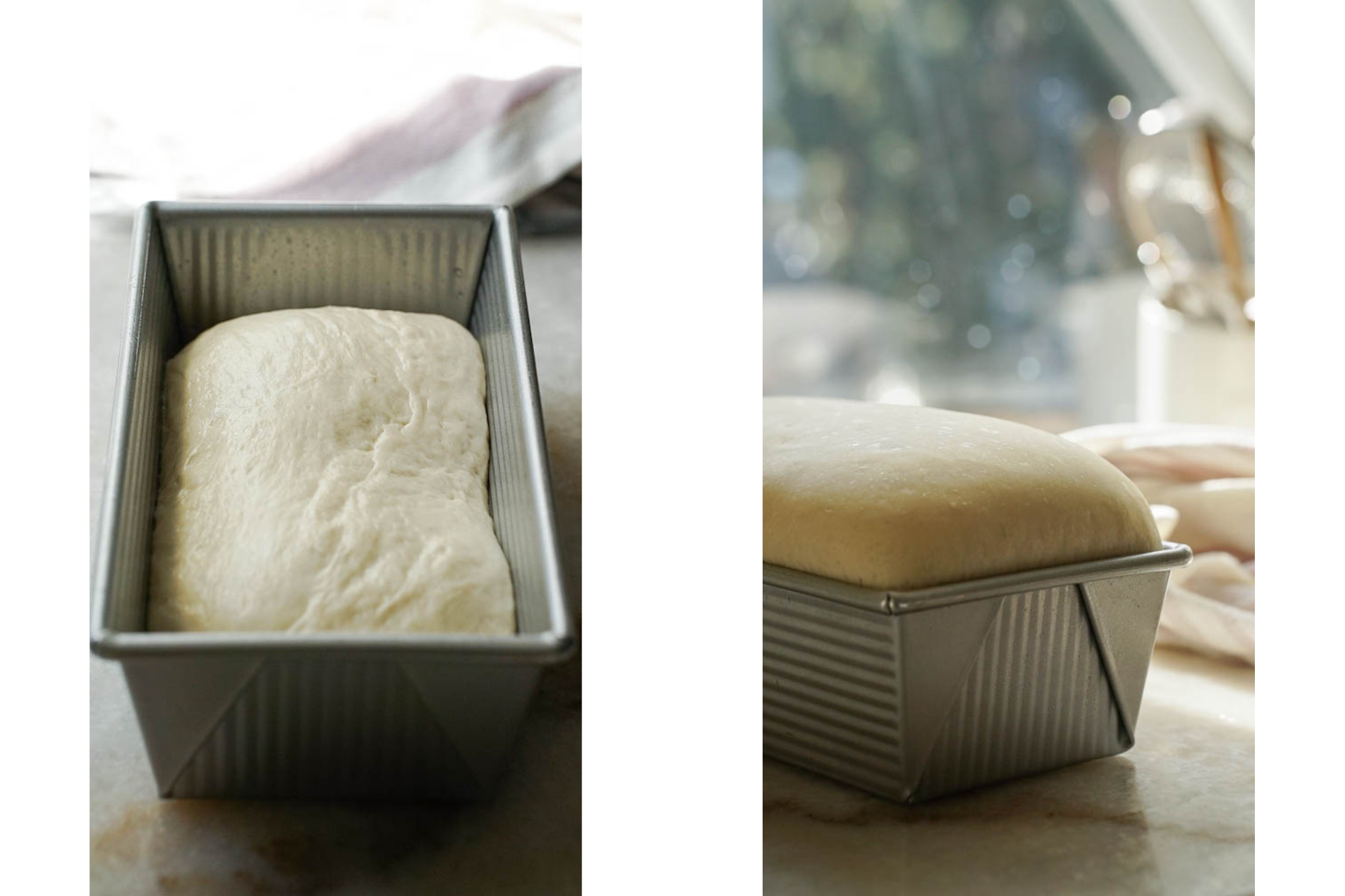

PRO TIP/ KITCHEN HACK
Rise above the tin – Allow the dough to rise at least 1 inch above the rim of the loaf tin. When poked, the dough should slowly bounce back leaving a faint indentation for a few seconds.
5. Doneness—Bake the bread on the bottom oven rack at 350F for 30 – 35 minutes. When it comes time to remove the bread from the oven, very carefully remove it from the loaf tin and tap the bottom of the bread—if it sounds hollow, then it has properly baked.
6. Let it cool—Cool the bread loaf on a wire rack and glaze it with melted butter all over—delicious! Allow the bread to sit for at least 10 minutes before picking up a knife. The cooler the bread is, the easier it will be to slice.
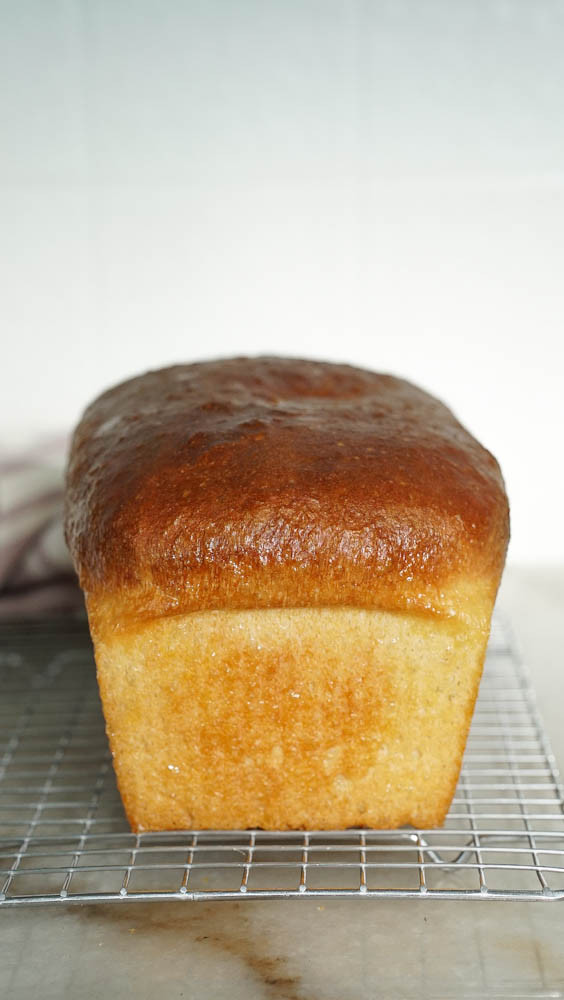
Keeping it fresh – This homemade white bread recipe will last for 5+ days at room temperature if wrapped with clingwrap and stored in an airtight container. You can also keep it in your fridge if you choose to.
Active dry yeast vs. instant yeast – The main difference is the convenience factor. Instant yeast, a time-saving option, can be added directly to your bread mix, eliminating the step of blooming it in lukewarm water for 5-10 minutes. While it takes a few minutes longer, active yeast offers the advantage of checking if it’s alive before adding it to your flour. This way, you can avoid compromising the remaining ingredients if the yeast is dead, making your baking process more efficient. By understanding these differences, you are empowered to choose the yeast that best suits your baking needs, enhancing your efficiency in the kitchen.
Dead yeast: Recognizing dead yeast is a crucial skill in baking. You can quickly identify if your active dry yeast is dead within a few minutes of adding it to your lukewarm water. If there is no reaction of yeast foaming or rising and spreading on the surface, and the yeast tends to clump together into larger balls, it’s a clear sign of dead yeast. On the other hand, active yeast should disperse evenly into an even layer. Mastering this skill will make you feel more knowledgeable and skilled in baking.
Proofing—When gently poked with the tip of your finger, the underproof dough will spring back completely correctly with no delay, proofed dough will spring back slowly and only halfway, and overproof dough will not spring back at all. Remember, this is a simple and straightforward process that you can easily master, making you feel at ease and confident in your baking techniques.
How to tell if bread is baked –
Underbaking Bread—Your bread will remain soft and doughy and will not easily pull away from the sides of your tin. You can put underbaked bread back in the oven and bake it for a short time, even if it has already cooled. Tent aluminum foil over the bread if you are concerned about the outside burning.
Internal temperature: The internal temperature of bread will vary for each type. However, if you insert an instant-read thermometer an inch into the bread, a reading of 190F is a good starting point. If you insert the thermometer from the side or at an angle, you can reduce the appearance of the hole left behind.
Color: Fully baked bread will be golden brown. Remember that different types of bread may have different appearances when fully baked. If the outside of your bread is very pale, it should go back into the oven.
Tap the bottom of the loaf: Let your loaf tin cool for a few minutes. When you can safely remove the loaf from the tin, tap on the bottom of the loaf. It should sound hollow inside, which is a good indication that your bread is baked.
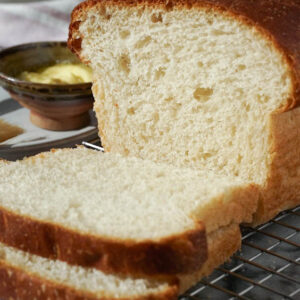
Good Day To Bake is a participant in the Amazon Services LLC Associates Program, an affiliate advertising program designed to provide a way for websites to earn advertising revenues by advertising and linking to Amazon.com. See the Privacy Policy for more details.
Kia Ora, and welcome to Good Day To Bake. My name is Courteney and here in this corner of the internet, you can find my collection of favorite recipes created in small batches, perfect for singles, couples, and cozy households – all of which can be increased to larger portions. You can learn a little more about me here